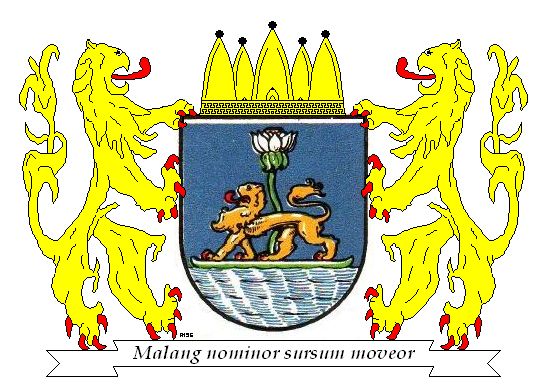Malang
| Heraldry of the World Civic heraldry of Indonesia |
MALANG
Province : Jawa Timur
Origin/meaning
I have no information on the origin or meaning of these arms. Any information is welcome.
Colonial arms
During the colonial times, Malang used several arms, see images below. The first arms were adopted on June 17, 1921 the second in 1936.
Official blason
- (1936)Van azuur met een schildvoet, golvend gedwarsbalkt van zilver en azuur in vier stukken, de bovenste balk ondersteunende een drijvend lotusblad en waaruit oprijzend een lotusstengel met witte bloem, alles in natuurlijke kleur; op het lotusblad en voor den stengel een gaande gouden leeuw, getongd en genageld van keel. Het schild gedekt met een gouden kroon van drie bladeren en twee parels. Schildhouders: twee leeuwen van houd, getoingd en genageld van keel.
Origin/meaning
The arms are mainly derived from the town of Singosari, as this was historically the main town in the region, and it belonged to the Malang municipality. The old arms show a lotus flower (sari) and a lion (singa), making it canting arms for Singoisari. The lion went through the lotus flower, which is a canting element for Malang (meaning diagonal or going through).
The municipality used two lions as supporters and a 'mural crown in Hindu style' as well as the motto Malang nominor sursum moveor (They call me diagonal, but I move upwards). The Dutch Court of Arms (Hooge Raad van Adel) rejected the mural crown and the composition. The very unconventional crown was not acceptable, as all cities should have a similar crown.The municipality reacted that historically Malang had been a walled city. The court also rejected the motto. So finally the arms were granted with the normal municipal crown as used in the Netherlands, with the supporters, but without the motto.
The local council finally adopted the new design, but still used the old crown for a long time.
| The full non-official arms from 1921 |
Proposed new arms in 1930 (?) |
| The arms in the Koffie Hag albums +/- 1930 |
Another composition with the lotus in a free canton. |
Literature : Rühl, 1933; Koffie Hag albums, 1920s and http://tlvima.leidenuniv.nl; Soerabajisch Handelsblad 01-06-1937.




